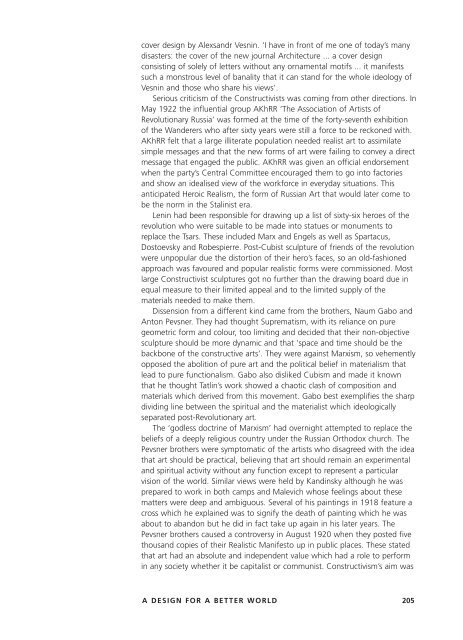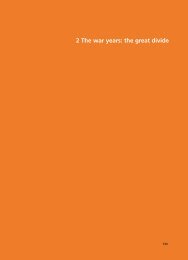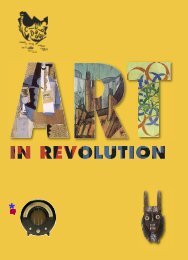Art in Revolution 3 - newleafdesign.me.uk
Art in Revolution 3 - newleafdesign.me.uk
Art in Revolution 3 - newleafdesign.me.uk
You also want an ePaper? Increase the reach of your titles
YUMPU automatically turns print PDFs into web optimized ePapers that Google loves.
cover design by Alexsandr Vesn<strong>in</strong>. ‘I have <strong>in</strong> front of <strong>me</strong> one of today’s manydisasters: the cover of the new journal Architecture ... a cover designconsist<strong>in</strong>g of solely of letters without any orna<strong>me</strong>ntal motifs ... it manifestssuch a monstrous level of banality that it can stand for the whole ideology ofVesn<strong>in</strong> and those who share his views’.Serious criticism of the Constructivists was com<strong>in</strong>g from other directions. InMay 1922 the <strong>in</strong>fluential group AKhRR ‘The Association of <strong>Art</strong>ists of<strong>Revolution</strong>ary Russia’ was for<strong>me</strong>d at the ti<strong>me</strong> of the forty-seventh exhibitionof the Wanderers who after sixty years were still a force to be reckoned with.AKhRR felt that a large illiterate population needed realist art to assimilatesimple <strong>me</strong>ssages and that the new forms of art were fail<strong>in</strong>g to convey a direct<strong>me</strong>ssage that engaged the public. AKhRR was given an official endorse<strong>me</strong>ntwhen the party’s Central Committee encouraged them to go <strong>in</strong>to factoriesand show an idealised view of the workforce <strong>in</strong> everyday situations. Thisanticipated Heroic Realism, the form of Russian <strong>Art</strong> that would later co<strong>me</strong> tobe the norm <strong>in</strong> the Stal<strong>in</strong>ist era.Len<strong>in</strong> had been responsible for draw<strong>in</strong>g up a list of sixty-six heroes of therevolution who were suitable to be made <strong>in</strong>to statues or monu<strong>me</strong>nts toreplace the Tsars. These <strong>in</strong>cluded Marx and Engels as well as Spartacus,Dostoevsky and Robespierre. Post-Cubist sculpture of friends of the revolutionwere unpopular due the distortion of their hero’s faces, so an old-fashionedapproach was favoured and popular realistic forms were commissioned. Mostlarge Constructivist sculptures got no further than the draw<strong>in</strong>g board due <strong>in</strong>equal <strong>me</strong>asure to their limited appeal and to the limited supply of thematerials needed to make them.Dissension from a different k<strong>in</strong>d ca<strong>me</strong> from the brothers, Naum Gabo andAnton Pevsner. They had thought Suprematism, with its reliance on puregeo<strong>me</strong>tric form and colour, too limit<strong>in</strong>g and decided that their non-objectivesculpture should be more dynamic and that ‘space and ti<strong>me</strong> should be thebackbone of the constructive arts’. They were aga<strong>in</strong>st Marxism, so vehe<strong>me</strong>ntlyopposed the abolition of pure art and the political belief <strong>in</strong> materialism thatlead to pure functionalism. Gabo also disliked Cubism and made it knownthat he thought Tatl<strong>in</strong>’s work showed a chaotic clash of composition andmaterials which derived from this move<strong>me</strong>nt. Gabo best exemplifies the sharpdivid<strong>in</strong>g l<strong>in</strong>e between the spiritual and the materialist which ideologicallyseparated post-<strong>Revolution</strong>ary art.The ‘godless doctr<strong>in</strong>e of Marxism’ had overnight attempted to replace thebeliefs of a deeply religious country under the Russian Orthodox church. ThePevsner brothers were symptomatic of the artists who disagreed with the ideathat art should be practical, believ<strong>in</strong>g that art should rema<strong>in</strong> an experi<strong>me</strong>ntaland spiritual activity without any function except to represent a particularvision of the world. Similar views were held by Kand<strong>in</strong>sky although he wasprepared to work <strong>in</strong> both camps and Malevich whose feel<strong>in</strong>gs about thesematters were deep and ambiguous. Several of his pa<strong>in</strong>t<strong>in</strong>gs <strong>in</strong> 1918 feature across which he expla<strong>in</strong>ed was to signify the death of pa<strong>in</strong>t<strong>in</strong>g which he wasabout to abandon but he did <strong>in</strong> fact take up aga<strong>in</strong> <strong>in</strong> his later years. ThePevsner brothers caused a controversy <strong>in</strong> August 1920 when they posted fivethousand copies of their Realistic Manifesto up <strong>in</strong> public places. These statedthat art had an absolute and <strong>in</strong>dependent value which had a role to perform<strong>in</strong> any society whether it be capitalist or communist. Constructivism’s aim wasA DESIGN FOR A BETTER WORLD 205





